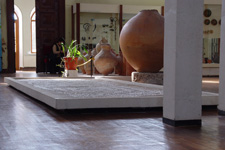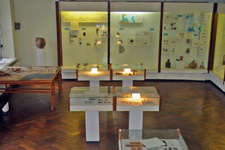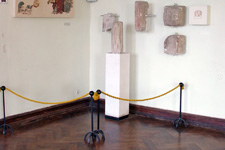|
Showcase III
|
Weapons of attack corresponded to the armours that
protected warrior: shield and helmet, plated armour and chain mail. In the
bottom part of the vitrine, you can see the remains of an iron chain mail.
Ships of Byzantine fleet were based in the port of Cherson. In the seventh century,
Byzantine sailors started to use the so-called "Greek fire," a prototype of
modern napalm. This burning mixture of rosin, sulphur and saltpetre was
impossible to extinguish with water, so it made enemy's ships incinerating like
torches.
In the centre of this vitrine, there are seals of
military officers: droungarios, who
was the fleet commander, hetaireiarches,
or the commander of foreigners' troop, and the seal of an interpreter.
At
the bottom on supports you can see small clay and stone balls used for shooting
with hand-ballista, and caltrops, or metal spikes to bring enemy's cavalry
about disorder. At the left part of the vitrine, there are horse trapping's
details such as loops, badges, and buckles.
|
|
|
|
|
Museum halls
|
Hall 1

Exhibition sections:
ВЕЛИКОЕ ПЕРЕСЕЛЕНИЕ НАРОДОВ_en; ГОРОДСКОЕ УПРАВЛЕНИЕ_en; Army; Religion; МОНУМЕНТАЛЬНАЯ АРХИТЕКТУРА И ИСКУССТВО_en; ГОРОДСКОЕ СТРОИТЕЛЬСТВО_en; РЕМЕСЛА_en; СЕЛЬСКОЕ ХОЗЯЙСТВО И ПРОМЫСЛЫ_en; | Hall 2

Exhibition sections:
ОБРАБОТКА КОСТИ И ДЕРЕВА_en; ТКАЧЕСТВО И ПРЯДЕНИЕ_en; БЫТ_en; МОНЕТНОЕ ДЕЛО_en; ТОРГОВЛЯ_en; РУССКО-КОРСУНСКИЕ СВЯЗИ_en; | Hall 3

Exhibition sections:
СЕВЕРНОЕ ПРИЧЕРНОМОРЬЕ И ВИЗАНТИЯ В XII – XIII вв._en; |
|
